Any cruiser that’s left the dock in US waters knows about the frustration of crab pot mazes. Leaving Annapolis and heading down the Chesapeake for our first “real” cruise, we were totally baffled. They seemed to be everywhere, requiring constant vigilance and turning what should be a pleasant, relaxing day long passage into a massive headache after straining our eyes for hours at a time to find the next ones so we can avoid them. There’s always the possibility of adding a line cutter to your prop, but here’s a post on our feelings on “The Great Debate”.
So THIS is cruising? Somehow in all the gorgeous cruising magazine articles, I missed this part. 🙂
On the other hand, I never miss the part about feasting on the catch of these annoying little crab pots! YUM!
When we first left US waters, I was convinced the best way to avoid crab pot mazes was to sail somewhere else. Then we discovered that while US crab pot mazes are usually marked with gaily painted bright styrofoam balls, elsewhere they might be marked with a twig, if that.

When we returned from Isla Mujeres, one of the first things we noticed (after a 5 day sail) was the re-emergence of CRAB POTS! I did some research to see if there’s any way we can tell from the charts that these mazes exist so we can avoid sailing in that area. Best I can tell, each state has their own regulations and if there are requirements that crab pots be placed only in specific areas — such as OUTSIDE a narrow channel that’s barely deep enough for our 5 1/2 foot draft, the crabbers seem to be ignoring them.
The only areas we’ve found crab pot free are national park or otherwise designated wildlife areas – which is one of the things that makes sailing the 10,000 Islands area (Everglades, FL) so pleasant. The pots are required to be outside a set of white markers – and it’s almost funny, the minute you pass one of the white markers, the pots seem to be swarming much like bees at a hive!
So how to avoid them?


1. Be diligent about watching for them, which can be the most difficult part, especially if the seas are up … now you see them, now you don’t! And whoever thought blue pots would be a good idea needs to be shot, they don’t show up against the blue water at all – black is almost as bad. Neon green, yellow, orange and red make it much easier!
Keep in mind, that just as soon as you think you’re clear and sit down for a relaxing lunch, VOILA, all of a sudden one will appear just off the stern causing both of you to jump to the watch in alarm. Phew, lucky we missed that one!
2. Realize that most crabbers set their pots in straight lines, placed at even distances apart (note, I said MOST, not all, there are constant exceptions). So when you spot a pot, look around to find the line that’s associated with it. Then cross through to the other side so they’re going away from you instead of coming closer all the time.

3. Notice the current, tide and wind. If you’re rapidly approaching a pot, always take it to the leeward or downwind side. That way you’ll make sure you don’t get tangled in the line that’s attaching the pot to the trap.
4. Then find a place you can sail through the line of pots without catching the line attaching the pot to the trap. This can be tricky since some crabbers put LONG lines on their pots, requiring giving the pot more clearance than others. Other pots will be almost straight up & down. In general, we like to error on the side of splitting the pots about 2/3 of the way between. Again, we choose to take the closer pot on the leeward or downwind side to avoid the attaching line.

5. And if you’re motoring or motorsailing and suddenly find a pot approaching that you didn’t notice and there’s no way to avoid it, put the transmission in neutral to stop the prop from turning. Avoid at all costs getting the line wound around the prop because that will totally shut down the engine.
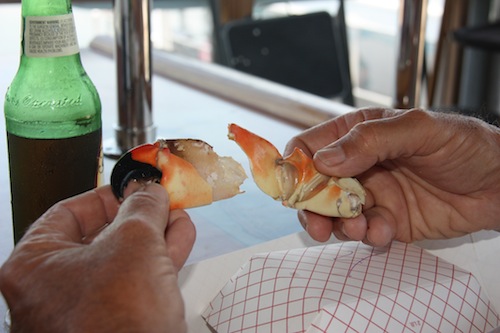
That’s about the only ways we know to avoid crab pots. So at the end of a stressful day negotiating crab pots, maybe the best remedy is to give in & go EAT crabs! At least you’ll have derived some enjoyment out of the hassle!
Anyone have other insight about negotiating crab pot mazes — or better yet, a concise explanation about how we can choose to sail in waters that are pot free?
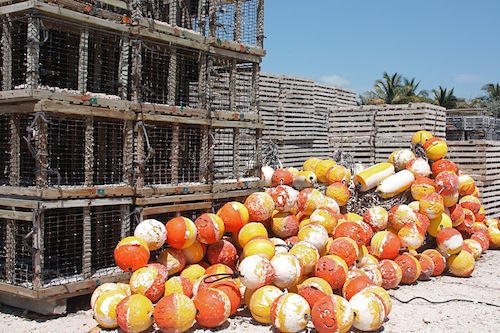





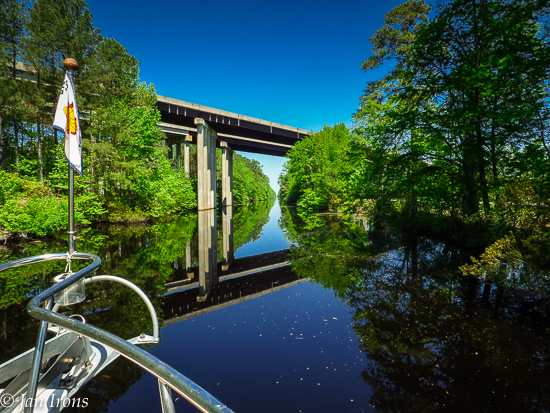







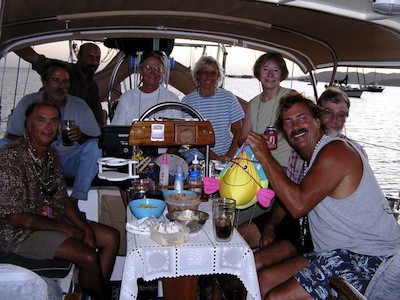
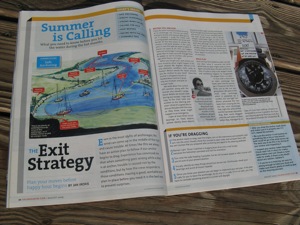

Polarized sunglasses can also help you spot them. And while we didn’t have crab pots in Mexico, we did have fishing nets . . .
Sometimes, you can spot them on radar better than by eye. Depends on what the markers are made of.
Another tip: don’t plan on sailing/motoring after dark if you’re in an area with pots or nets.
Our first trip south we were completely frustrated by the pots. We arrived in Annapolis and thought ‘Sailing capital? With all these pots in the way?’ I do miss the freedom of Great Lakes sailing…for the three months we could sail.